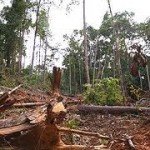Malaysia is home to probably the oldest rainforest in the world. 130 million years to be exact. The forests all over the country is facing a constant threat from logging and development. We but cannot look at it inwardly but in a global perspective. In 2007, the 13th round of climate change talks were held in Bali. This involved the issue of reducing gas emissions from deforestation in developing countries. Major efforts have been carried out by the international community, donor countries and rainforest countries. Nonetheless, significant challenges remain. The economic drivers of deforestation are strong. Global demand for timber, palm oil, sugar, soya and beef, increasing in the light of population growth and higher standards of living. This and higher standards of living will continue to yield pressure on the forests. How do we help reduce global deforestation of forests? Significant incentives need to thought off. Leaving it business as usual will result in devastating consequences. Firstly, the destruction of tropical forests could cause as much as one sixth of all global greenhouse gas emissions. The two degree target will be impossible to reach without significant reductions in tropical deforestation. Secondly, forests are the home of indigenous peoples, and constitute a safety net for some of the world's poorest people. One billion people depend directly or indirectly on forests for their livelihoods. Thirdly, tropical forests contain half of the world's terrestrial species on only seven percent of the world surface area. Biodiversity is the natural capital for sustainable development. Today, 17.000 plant and animal species are endangered globally. You could say that life's library is in flames and extinction is forever. The loss of biodiversity in our age can be compared to previous mass extinctions, but this time, human beings are the ones responsible. Degradation of ecosystems combined with climate change may lead to so called "tipping points" that could make negative developments spin out of human control altogether. The prospects of saving the world's remaining fainforests have looked positive. At a recent UN climate change negotiations in Durban, South Africa, the international community further discussed a framework to work collectively to slow, half and reverse emissions from forests in developing countries.< A broad spectrum of forest countries have emerged to get Reducing Emissions from Deforestation and Forest Degradation on the ground. A variety of academic institutions and NGOs are creating a global community to support this action. We are learning and sharing valuable lessons everyday. With more developing countries willing to step up their efforts to reduce deforestation and forest degradation, there is every reason to be optimistic. Post By : Francis - Nature Guide

